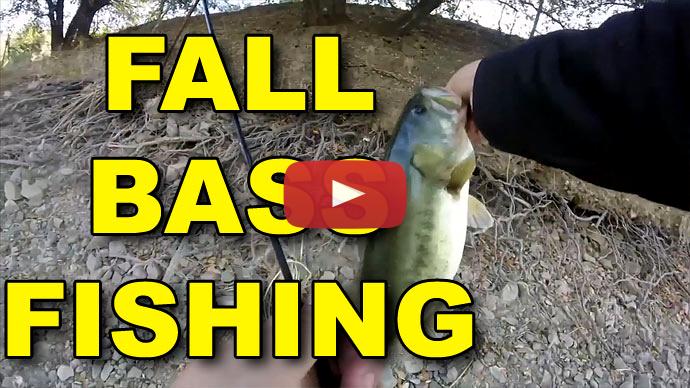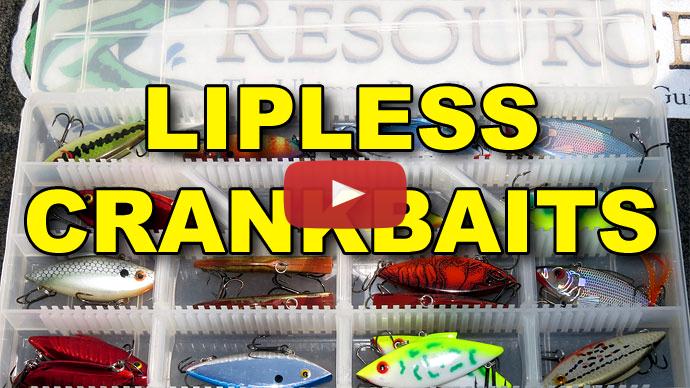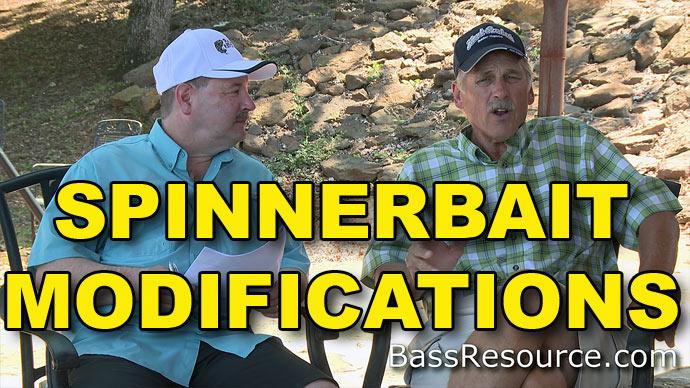Hey folks, Glenn May here at BassResource.com. And today, let's talk about fall fishing and how to be successful throughout the whole fall season. I know it can be a little bit challenging because the bass seem to be scattered and they're hard to find sometimes. But if you follow the tips I'm about to give you, it's gonna be a lot easier for you. So let's start off with the forage.
Right now a bass, when they get into the fall season, they're getting…they're feeding up getting ready for the winter. So they're chasing down whatever available forage they have. And that could be for the most part is baitfish.
Now, understanding the role of the baitfish, their behavior during the fall and what they do can really help you find the bass because wherever the baitfish are, that's where the bass are. So, take shad, for example. If you have shad in your lake or in your river, shad are pretty easy because they're very predictable.
What they do is in the early…well, late summer, early fall, they're a little bit deeper out in the main lake, and as fall progresses, they move up shallow. They move into the back of base, back of coves, move up streams, tributaries, or if you're in a river system, they move upstream. What they're doing is they're looking for oxygen-rich water with a lot of cover available that they can hide in, where they can feed. And so the bass will follow them.
So, it's predictable that the bass will be up shallow, about mid-fall and then they reverse that process. The shad start to move back out, move out deeper as you get closer to winter, and the bass will follow them on out. So understanding that shad behavior really helps you find the bass. However, what if you're looking at your depth finder and you see these blips, big balls of baitfish and stuff. How can you tell if it's shad?
Let me give you a secret. It doesn't matter. Okay? Really, it doesn't matter. Whether it's shad or some other form of baitfish, if it's some kind of baitfish, the bass will be there. So this also is true, if your lake doesn't have shad understand what the predominant baitfish are in that lake. For example, if it's perch, or if it's gobies, or bluegill, that sort of thing, they're gonna go after them and feed on them. So, understand how those behave.
So for example, perch. Perch, towards the middle of fall and towards the end of fall, the perch will begin to school up in these big balls of schools. And they'll be out and a little bit offshore relating near the cover or near structure, and the bass will get up underneath them and feed on them. Knowing that will help you find the bass. Bluegill like to get up shallow, and get up in those weeds and such, and that's where the bass will go to follow them. So find the baitfish, find the bass.
Now, let's take a little bit more consideration. Let's think about cover. Cover is the form of anything that's not part of the bottom structure. So weeds, for example. There's really three different types. There's three… There's weeds, there's rocky cover, and then there's wood. So let's start with weeds.
Weeds, what the bass like to do…or the baitfish will like to do is get up in those weeds and it helps them hide from their predators. And it helps them feed because it attracts insects and zooplankton. And that's what the baitfish feed on.
And the weeds in the summer to the beginning of fall are very abundant and really thick in a lot of lakes and that's where the…that's why…one of the reasons why the baitfish will be up shallow. Now as fall progresses and the water temperature begins to drop, the weeds start to die off in the shallow areas first, and progressively deeper and deeper.
Well as they die, the weeds consume oxygen. Well, that's not what the baitfish want. Like I said earlier, they want oxygen-rich water, so they'll move away from that. If you find dead and dying weeds in the fall, don't fish it because chances are there's not gonna be a lot of fish in there. Move out deeper till you find the greener weeds and that's where you're gonna find the baitfish.
Until progressively towards the middle to end of fall you're fishing the outside weed lines and 10 to 20 feet of water. And that actually concentrates a lot of fish too. So you can really find good concentrations of bass on these outside weed lines, because that's where they're feeding on the baitfish, towards the middle and in the fall.
Now, what if your lake doesn't have a lot of weeds? Well, like I said, there's two other types of cover available. There's rock and there are woods. So let's talk about rock. Rock, for example, is, riprap on faces of dams, or they can be seawalls, anything that's made out of a hard, rocky surface. It could be a chunk of rock on a flat, that sort of thing. Algae will grow on rocks, and that attracts the baitfish to feed on. And of course, like I said, where the baitfish are, that's where the bass are.
So rocks and riprap can be really good areas to find fish, especially in the fall, because that's again, where the bass are gonna be feeding on those baitfish. What is the same sort of thing? Wood is like dock pilings, or bridge pilings, docks that can be wood, laydowns or logs on the bottom of the lake. Again, it's organic compound. Algae grows on it. The same thing there, you're gonna find baitfish in those areas.
So while you're looking… In the fall, when you're moving from deep from summer, shallow in mid-fall, and then back to deep again, look for these types of cover to find…well, that's where the bass will be staging along, either moving or shallow or moving back out deep. That's where they're going to be hanging out on as fall progresses.
Now, let's talk a little bit about structure. Because we're talking about different depths, structure's really where they're gonna be the main highways where these fish are going to be anytime during the season. Structure comes in the form of points, secondary points. What secondary points are those points that are inside of coves and bays. They're gonna be flats. They'll be channels, streams, creek channels, and that sort of thing.
When the baitfish move up shallow, they're gonna be up on those flats, not deep all the way to the back of flats, but they'll be towards the edge of them, near deeper water. This is why I like to look for creeks and channels that go in these bays because you get a nice swing, channel swing goes up towards the shoreline, you're gonna get this steep drop from shallow to deep. And that's a prime area where you can find these fish that are stacking up in that area, or the inside of the swings where you've got a shallow, kind of a more of a flat. If you can find cover such as stumps or a chunk of rock, man, I'm gonna slap you if you don't fish those areas because those are gonna be very, very productive.
So look for those areas back in those bays and coves. And then as the fall progresses and it gets colder and colder, again, look a little bit deeper, a little bit deeper channels. Look for those rock piles and those humps, and ledges. And then as you get towards the end of fall, you're looking for steeper drops. The closer the contour lines on your GPS map, the better.
Or if you're looking at a paper graph, those steeper drops is what you want to look for towards the end of fall because they have a quick access from shallow to deep, and they're out there towards the main lake. So that's the areas that I like to target. You look for that structure and then that cover that I just talked about that's sitting on that structure and you've got yourself a sweet spot. So those are what you wanna look for.
As for the baits to use during the fall, like I mentioned many times over, baitfish. So, you need to have the baits that mimic a baitfish. And there really is no other bait out there that does a better job of mimicking baitfish than a crankbait. So I essentially use three different types of crankbaits during the fall. One of them is a lipless crankbait.
This I'll use throughout the fall but I use it a little bit differently. In the early part of the fall into the mid-fall when the fish are shallow I like to use them in two different ways. One, I will bring it back quickly, rapidly right over the tops of the weeds, and right along docks and pilings. And I wanna move in fast because the activity level is up. Their metabolism as a baitfish, they're moving quickly. I'll also bring it along the outside weed lines and in the deeper creaks and drops.
What I'll do is I'll throw it out there and let it drop down a little bit down deeper. You can...that's the nice thing about these baits, is you can control the depth. And I'll bring it along the…bring it along those, excuse me, bring it along those edges a little bit slower. And hopefully, those bass will come out and ambush those baits.
Here we are. There you go. I know I’m holding him weird, but… Lipless crankbait.
Now, as you get from the middle of the fall towards the late part of the fall, the lipless crankbaits I'll change them up a little bit. Water temperatures are cooling, the activity level's beginning to die down. So what I'll do then is, I like to use a drop retrieve.
As the fish are getting deeper, I like to throw it out there and let it drop all the way down, just straight down. It wobbles like this all the way down. Let it fall, let it hit to the bottom and then rip it up off the bottom and let it fall back down. A lot of baitfish are dying during this time of the year. So you're mimicking that action which is triggering that bite. So let it fall all the way down and just rip it up off the bottom on those main structure areas that I talked about earlier. And if the bass are there, they're gonna smack it.
Now, there's two different deep-dive crankbaits that I like to use. In the early part of the fall, I'll use a deep-dive crankbait that has a wide lip. The wide lips are great because what they do is they give it a lot of action. The bait is… Lots of sashay, moving around, lots of vibration, it causes quite a bit of commotion. The activity level is up during this time of year, end of summer into early fall.
So that's what I want. I want to bounce it off things and ricocheting and just being really erratic and causing a lot of commotion, and you can get a lot of bites that way. Try to knock it off dock pilings or off those chunk, off rock on those flats. As you get from mid-fall to late fall, then I move to a narrow bait, a narrow bell. So it has a much tighter action. It's not as pronounced. It doesn't make as much commotion.
Again, everything's beginning to simmer down. There's not as much action going on. So you're mimicking that action, basically matching the activity level of baitfish. But it still dives down to the same depths if not deeper, because the fish are deeper, and that's what I wanted to do, is get down there. Maybe ricochet it down there but not a ton of commotion.
Colors for these baits is really simple. For the lipless crankbaits, I'm using a chrome with a black back or a chrome with a blue back. And with the other crankbaits, firetiger. You just can't go wrong with firetiger. Now I'm not saying the other colors don't work, they do, but if I were fishing in a lake that I never fished on before anywhere in the country, during the fall I'd be reaching for a firetiger bait because it's just…it's a gimme. It works really well.
Some people like to use sexy shad and some other colors, but firetiger's a go-to color for me.
Another bait that I like to use during the fall is spinnerbait. Spinnerbait, it does mimic a baitfish. So, during the early part of the fall, I'm bringing it back really fast. I like to burn it across the tops of weeds. I like to bulge the surface, get that reaction strike.
There we go.
As the fall progresses, and it gets…in the mid-fall or the late fall or if these fronts come through and the fish are being really lethargic then I like to slow roll it on the outside of these weed lines, especially when they're getting out, when the weeds have died and they're out there from 10 to 15 feet, 10 to 20 feet deep on those weed lines. Let it flutter all the way down, just like you did with that lipless crankbait, let it fall straight down.
A lot of times you get bit during that fall. Let it hit the bottom. And then just slow crank it right along the bottom of those weed lines. And a lot of times you get bit, especially if the fish are really lethargic, maybe a front came through. They, sometimes, they just smash it. Man, they'll just crash that spinnerbait. Simply just use a white or white or chartreuse with the threader on it. And I like to have just gold blades to give a little bit of vibration.
Another bait that I like to use is a jerkbait. And I just use two different types. In the early fall when they're shallow, early to mid-fall when they're shallow I use like a Rapala number 11. It's a floater/diver. It only goes a couple of feet deep. I like to just use it as a regular jerkbait, giving it hard jerks, giving it a couple of pauses in between, random. It doesn't matter. You can do three, three, three, let it pause for five seconds, three, three, three and let it pause, or three, two, one, two and let it pause or one, let it pause, whatever. It's just random. It doesn't really matter. Just give it a little bit of erratic action.
And then as you get more into the deeper part of fall, now you're using deeper diving suspending crankbaits that get down to 10 feet or more. And same action but not as hard, not as pronounced, maybe one jerk and just let it sit and then let the pauses last longer in between. And those are the...that's the three that works really well with these minnow type crankbaits.
So, another bait I like to use throughout the fall is a topwater bait, namely like a popper or a chugger, something that looks like an injured minnow that sits on the surface, it looks like a little minnow, and you just give it a couple little pops and let it sit.
Look at you. You're a largemouth. Look at you. Look at the belly on that dude! Look at that. He has been feeding! And he ate that popper. Topwater fishing, man, it is so much fun.
It works really well during the fall, basically, anytime during the fall but especially if you see bass that are popping baitfish on the surface. If they're within casting distance and you can throw that into the fray and just give it a couple of pops you're gonna get whacked, boom, really quick. So using a popper can be a really effective way of catching fish during the fall.
Anyway, I hope those tips help. You follow those, trust me you're gonna catch a lot of fish this fall. Use them, go out there, catch a bunch of fish, have a lot of fun. For more tricks like this, visit BassResource.com.




